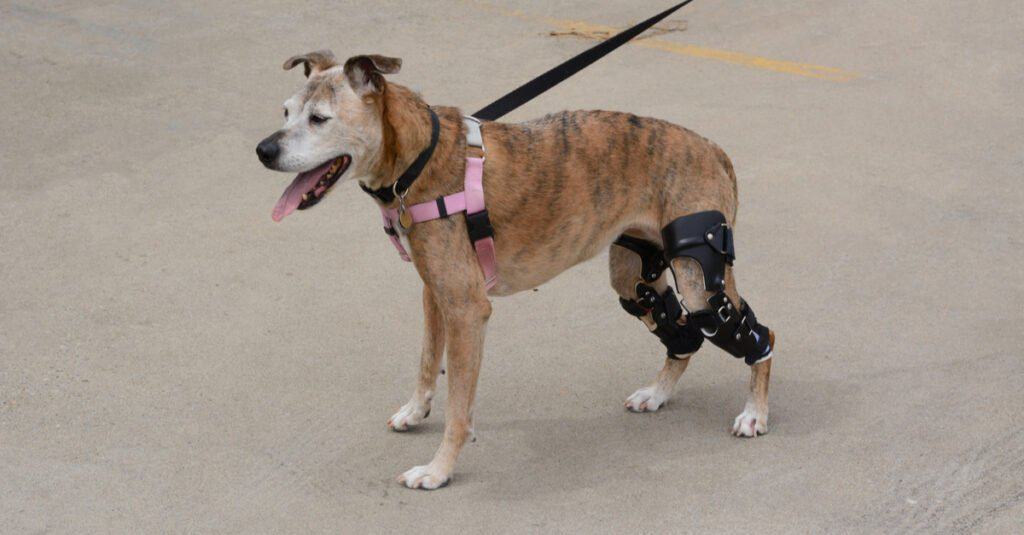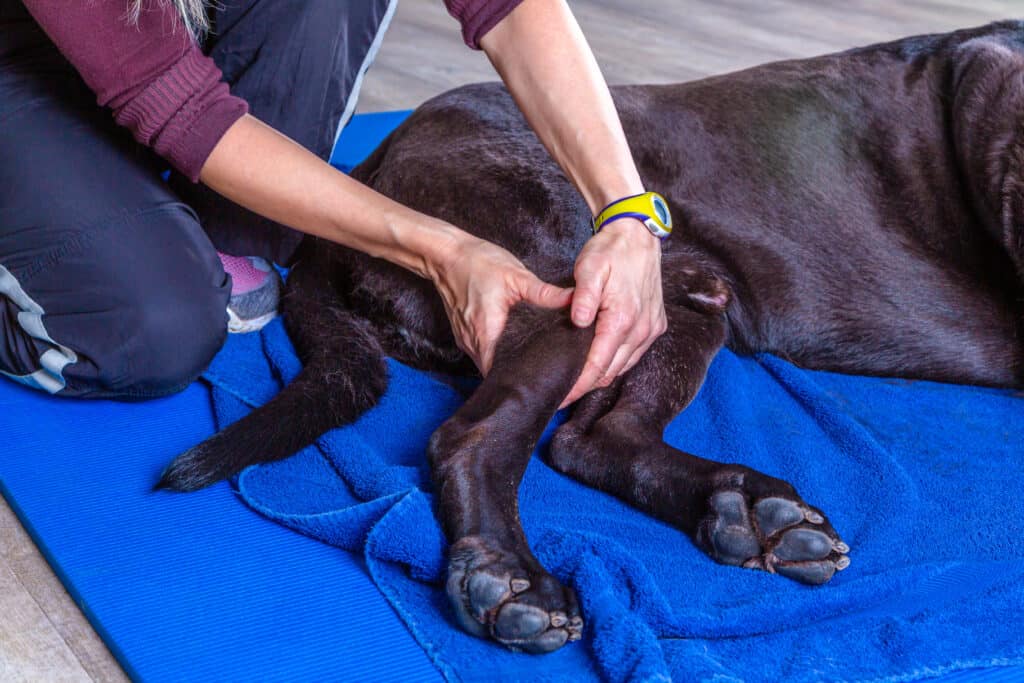A torn cranial cruciate ligament is a serious injury in our canine companions. Not only is it incredibly painful, but it can deeply impact a dog’s agility and range of motion. Due to how impactful this injury is, many vets will recommend surgery for a torn CCL in dogs.
If you have just been told that your dog needs surgery for their torn CCL, you are likely faced with questions about what lies ahead. We want to make sure you feel confident about your dog’s treatment plan and road to recovery. Let’s break down the details of injury, the most common surgeries, and how to determine what is best for your pup!
What Is a CCL in Dogs?

The canine CCL is one of the main support structures within the knee.
©Merrimon Crawford/Shutterstock.com
Let’s first discuss the CCL ligament and its functions. The cranial cruciate ligament (CCL) in dogs is very similar to the anterior cruciate ligament (ACL) in humans. This is often why the terms CCL and ACL are used interchangeably when discussing this injury. Comparisons can help pet parents better understand how impactful this injury is.
Similar to the human ACL, the canine CCL is one of the main support structures within the knee. With such a major role, any injury to this ligament can lead to serious mobility complications. A strained or torn CCL in dogs can lead to severe pain, inability to stand on the leg, swelling of the knee joint, and chronic changes of the knee that can develop over time. A torn CCL can deeply impact quality of life. You will need to pursue treatment to relieve your dog’s pain.
How Do Dogs Injure Their CCL?
Some pet parents will know exactly how their dog’s injury occurred because your pup will suddenly cry out during activity. However, this is not always the case. If you take your limping dog to the vet and recieve a torn CCL diagnosis, you may be wondering how this happened. There are many ways for our canine friends to injure their knee, but there are a few traumas that are most commonly linked to CCL injuries in dogs.
Some of the most common factors behind a CCL injury in dogs include:
- Twisting of the knee joint, which often happens when a dog suddenly switches directions when running
- Accidently stepping or tripping over a hole when running
- Falling off or jumping off a high surface and landing on their feet
- Natural deterioration of the knee joint due to a previous injury, severe arthritis in the knee, or even vigorous activity for long periods
- Unethical breeding that led to growth complications
Our canine friends can injure their knee in many ways, but these are the most common scenarios. The above factors can cause issues ranging from ligament strains to complete tears. The only way to determine the severity of their injury is to have them assessed by a vet.
Is Surgery the Best Option for a Torn CCL in Dogs?

Dogs that do not receive surgery for their torn CCL are at risk of prolonged pain, further ligament trauma, and thickening of the knee joint.
©msgrafixx/Shutterstock.com
If your dog has just injured their CCL, then you may wonder if their injury can heal without surgery. While this can happen for some dogs with minor ligament tears and strains, it does come with many risks. Dogs that do not receive surgery for their torn CCL are at risk of prolonged pain, further ligament trauma, thickening of the knee joint, and severe arthritis in the area over time.
Though some dogs can recover with strict exercise restrictions and a knee brace, most vets will recommend surgery. There are less risks associated with CCL surgical repairs, and dogs have a much better chance at a full recovery. Your veterinary team will likely suggest that your pup has surgery to repair the CCL.
Now that you understand how the CCL functions and why it’s a big deal, it’s time to discuss the four types of surgery. We will discuss the TPLO, the TTA, the Lateral Suture Repair, and the Tight Rope procedure. Ranging from the surgical methods to the recovery time of each surgery, let’s break it all down!
Educating yourself on the four types of CCL surgery in dogs is important. However, your vet will make the ultimate decision on which surgery is best for your dog.
1. TPLO Surgery
A Tibial Plateau Leveling Osteotomy, or TPLO, is the most common surgery to repair a torn CCL in dogs. It offers smooth healing for most canine friends, and it has a high success rate. The TPLO surgery in dogs involves removing the damaged portions of the CCL, as well as removing any damaged parts of the meniscus (within the knee).
The surgeon will then restructure the dog’s knee by making an incision near the dog’s tibia, rotating the tibial plateau, and securing this new position with plates and screws. The purpose of a TPLO is to create a knee that no longer relies on the support of the cranial cruciate ligament.
When all goes well, the standard recovery time for a TPLO in dogs is about eight weeks. After this point, the pup can put normal pressure on the leg again. Full recovery is achieved in 12 weeks. Just keep in mind that you will need to implement strict exercise restrictions until your dog recovers, and you may need to utilize physical therapy if your vet suggests it. The average TPLO procedure costs $3,000 to $5,000 per leg.
2. TTA Surgery
A Tibial Tuberosity Advancement, or TTA, is a CCL surgical repair method common for small to medium sized canines. This procedure involves making an incision in the dog’s tibial tuberosity, and then restructuring the position of the dog’s tibia. The ultimate goal is to make sure the tibia aligns with the ligaments within the dog’s patella, and then securing the new knee position with surgical screws and plates.
The standard recovery time for a tibial tuberosity advancement in dogs is about eight weeks for normal pressure on the leg, and 12-14 weeks for a full recovery. You will also need to implement strict cage rest until your dog recovers, and you may need to utilize physical therapy. The average TTA procedure in dogs costs $4,000 to $6,000 per leg.
3. Lateral Suture or Extracapsular Repair
The Lateral Suture Repair, or the Extracapsular Repair, is a CCL surgical method that is most common in dogs under 35lbs. This procedure relies on the formation of scar tissue around the surgical site, so this method can typically only support a small dog’s size.
This CCL surgery involves the surgeon placing a suture on the outside of the canine knee joint, and then passing this suture around to the back side of the dog’s femur. They will then feed the suture into a drilled hole in the dog’s tibial tuberosity, which ultimately forms an anchor. The dog’s body will then form scar tissue around the knee anchor, and this is what ultimately supports the knee joint.
The standard recovery time for a lateral suture repair in dogs is about eight weeks for them to stand comfortably on the leg again, and 12 weeks for a full recovery. You will also need to implement strict exercise restrictions until your dog recovers. Physical therapy is also a possibility. The average cost of an extracapsular repair in dogs is $1,500 to $3,000.
4. Tight Rope Procedure
The Tight Rope surgical repair is a new method. It is minimally invasive, and surgeons that use this approach state that it offers more stability to the knee. This procedure involves utilizing an implant called Fiber Tape, which is specifically created for this procedure. The surgeon will drill holes through the dog’s femur and tibia, and pass the Fiber Tape through these passages. They then secure the Fiber Tape with toggle buttons, and this works like a strong anchor to support the knee.
Due to this being less invasive than the average CCL repair surgery, the Tight Rope repair typically costs anywhere from $500 to $1500 per leg. However, it’s important to mention that most experts only recommend this method for small to medium sized dogs.
How Do I Know What Is Best for My Dog?
Each of the options we discussed above are effective ways to repair a torn cranial cruciate ligament, so how do you know what is the best option for your beloved companion? Thankfully for any concerned pet parents, your vet will be the one to make the ultimate surgical decision for your pup.
Your vet will assess the details of the case, ranging from the severity of the injury to the dog’s size, and they will point you in the best direction for torn CCL treatment. Just keep in mind that if your vet is a general practice vet that does not offer orthopedic surgery, they will likely refer you to a veterinary surgeon in the area.
Final Thoughts
We understand how worried you are about your dog with a torn cranial cruciate ligament. Thankfully, surgical repair of a CCL injury is often successful, and most dogs go on to live normal and happy lives. We suggest trusting your vet’s guidance each step of the way!
Summary of the 4 Types of CCL Surgery for Dogs
| Surgery | Recommended For | Recovery | Cost | |
|---|---|---|---|---|
| 1 | TPLO Surgery | Most dogs | 12 weeks total | $3,000 to $5,000 per leg |
| 2 | TTA Surgery | Small – medium dogs | 12-14 weeks | $4,000 to $6,000 per leg |
| 3 | Lateral Suture or Extracapsular Repair | Dogs under 35 pounds | 12 weeks total | $1,500 to $3,000 per leg |
| 4 | Tight Rope Procedure | Small – medium dogs | 8-12 weeks | $500 – $1,500 per leg |
The photo featured at the top of this post is © Tatyana Vyc/Shutterstock.com
Ready to discover the top 10 cutest dog breeds in the entire world?
How about the fastest dogs, the largest dogs and those that are -- quite frankly -- just the kindest dogs on the planet? Each day, AZ Animals sends out lists just like this to our thousands of email subscribers. And the best part? It's FREE. Join today by entering your email below.
Thank you for reading! Have some feedback for us? Contact the AZ Animals editorial team.






